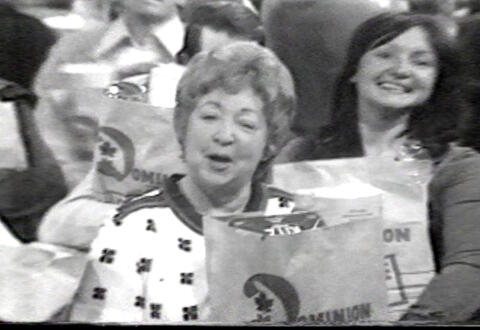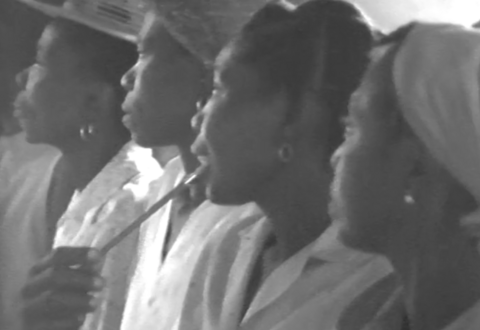
Vidéographe at 45
This program explores the diverse range of practices that coexisted at Vidéographe during its first decade: social documentaries, technical experiments, arts documentaries, commentaries on international events, and more.
Curator at Vidéographe since 2015.
List of works in program
This year, Vidéographe, the brain behind Vithèque, celebrates its 45th anniversary as an independent organization. Set up by the National Film Board of Canada (NFB) in 1971, Vidéographe received its letters patent on 9 April 1973. It is one of the oldest centres dedicated to video and one of the few to still be active, along with Experimental Television Center and Electronic Arts Intermix.
The current program explores the diverse range of practices that coexisted at Vidéographe during its first decade: social documentaries, technical experiments, arts documentaries, commentaries on international events, and more. This survey is unavoidably incomplete, so great is the scope of the some 260 titles that we still have from this period, but it is intended as a nod of respect to those who have contributed to Vidéographe’s history and to the history of video in Quebec.
A brief history of Vidéographe
1971
Vidéographe opens its doors on St Denis Street, at the instigation of Robert Forget. The centre is set up as part of a National Film Board (NFB) initiative intended to democratize the production and dissemination of video. In a sense, it is a radicalization of Société Nouvelle / Challenge for Change. Vidéographe comprises a video production studio, a screening room, a video library, and a technical research lab.
1973
The NFB pull out of the venture and Robert Forget, Michel Cartier, Jean-Paul Lafrance, Louis Martin, and Robert Russel proceed to have Vidéographe incorporated as an independent organization.
The 1970s
Vidéographe becomes a flagship model for video production thanks to its experimentation lab, its screening space and its active community. Its members are keen to make videos and people from different milieux (arts, unions, sociocultural) come together. Video production becomes increasingly popular.
Vidéographe earns international recognition for its technological innovations, such as the editometer, which is subsequently marketed. In partnership with Vidéotron, Vidéographe also develops Sélectovision, which offers video-on-demand via cable television.
The organization establishes a distribution network for independent video. This network will go on to serve as a model for Canadian and European distributors.
Although these years are fruitful, the centre is hit by two financial crises over the course of the decade (1973 and 1976). Vidéographe goes bankrupt and temporarily closes its doors in 1976.
The 1980s
With a change in fortune, Vidéographe wins a Bingo prize of $200,000. The deficit is met and Vidéographe buys a two-storey building in the heart of the Plateau Mont-Royal, a flourishing and densely populated district of Montréal (1981). The building is still home to the organization today.
Video becomes more and more established within the fields of cinema and the visual arts. Vidéographe collaborates on a number of events with other organizations that were active at the time, notably the exhibition Vidéo 84 – Rencontres vidéo internationales de Montréal (Video 84 – International Video Conferences, Montréal), which marks a significant milestone in the history of video in Quebec.
The 1990s
Vidéographe’s building is renovated in order to accommodate state-of-the-art digital editing suites. In 1998, l’Espace Vidéographe, an exhibition space dedicated to media arts, opens its doors in Montréal’s downtown area.
A management service for the documents and cataloguing of Vidéographe’s important collection is set up. Three funds, Vidéographe, TVC-4 (Saint-Jérôme) and Sonographe, are established and entrusted to the Cinémathèque québécoise and Sonothèque.
The 2000s
Vidéographe creates PARC, a laboratory that brings artists, programmers, and electrotechnicians together and offers access to specialized infrastructures for research and production in digital, interactive, and electronic arts.
Vidéographe produces a set of DVDs dedicated to Robert Morin, Pierre Falardeau and Julien Poulin, Charles Guilbert and Serge Murphy, and Donigan Cumming. A collection of conversations with Robert Morin and a monograph on the work of Sylvie Laliberté are also published.
In 2008, Vidéographe initiates Vithèque, an innovative online distribution platform. A dispute with a technical partner leads to a financial and organizational crisis for Vidéographe.
The 2010s
Vithèque, launched in 2010, is reviewed and improved upon in 2017 in order to allow better access to works.
Following some difficult years and an extensive process of reflection, Vidéographe repositions itself within its sector. The centre focuses its interventions on dissemination and distribution and sets up new initiatives to promote research, dissemination, and education in its field. In order to realise these new ambitions, fruitful partnerships are established with Montréal arts and community organizations. Vidéographe’s administrative and financial health is restored.
Today
Vidéographe conserves and distributes a collection of more than 2,250 videos made by more than 800 artists and engaged citizens. Thanks to Vidéographe, these works are showcased nationally and internationally through programming and distribution at festivals, galleries, museums, colleges and universities, as well as via the Internet. This video collection is one of the most important in Canada and is undeniably part of the country’s cultural heritage. It shines light on the social and artistic issues and movements that have helped shape cultural life in Quebec and Canada since the 1970s.
Vidéographe is also a vibrant space for artists’ research and development. Through its residential and training programs, as well as the access to work spaces and guidance that it provides, it fosters experimentation and promotes knowledge sharing. Vidéographe broadens opportunities for artists, curators, and researchers to meet and exchange ideas, stimulating its community while facilitating the development of expertise and practices.
Vidéographe constantly monitors technological developments in order to refine its services and develop innovative strategies to support artists.
Vidéographe promotes accessibility to culture. It uses different dissemination strategies in order to reach specialists, students and the general public alike, and to facilitate better appreciation of Quebecois and Canadian cultural heritage. It offers a regular program of screenings and exhibitions as well as mediation and digital experimentation activities for adolescents.
See also: Selected readings about Vidéographe
Image: Vidéographe, Sélectovision, 1972












